Welcome to the 2021 edition of Quill & Pad’s early Grand Prix d’Horlogerie de Genève predictions in which the team picks favorites and explains why.
The panelists are:
Elizabeth Doerr (ED), co-founder and editor-in-chief
Ian Skellern (IS), co-founder and technical director
Joshua Munchow (JM), resident nerd writer
GaryG (GG), resident collector
Martin Green (MG), resident gentleman
The Diver’s category contains watches linked to the field of diving, whose functions, materials, and design are suited to this activity.
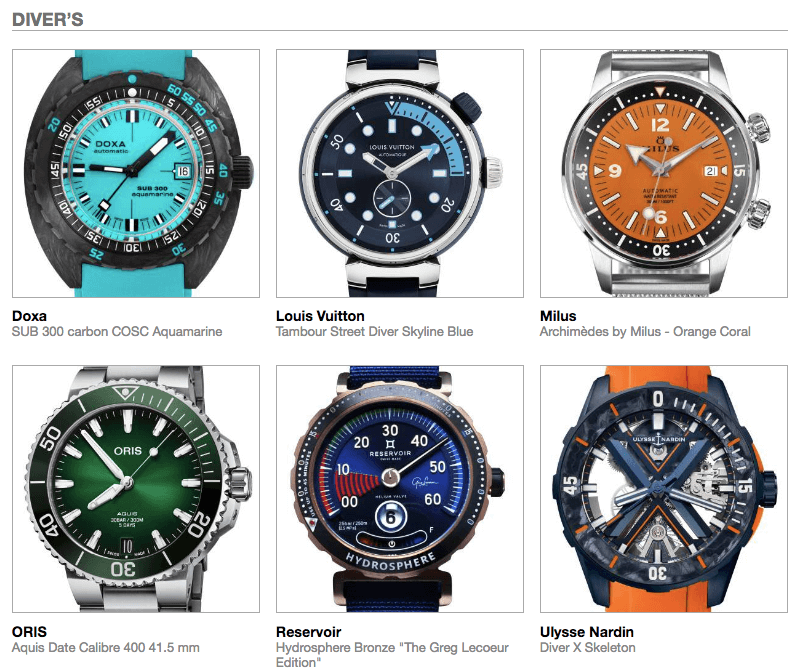
Nominated Diver’s watches in the 2021 GPHG
MG: There is never a shortage of diver’s watches in the watch world, so it’s interesting to note that three of the six models were also nominated in the 2020 GPHG, although in different versions: the Doxa SUB 300, Reservoir Hydrosphere, and Ulysse Nardin Diver X couldn’t prevail last year against Breitling’s Superocean Automatic 48 Boutique Edition. Maybe they have more luck this year?
ED: Interesting observation, Martin. And since Breitling is not competing in this category this year – though it is in competition in three other categories right now! – perhaps one of those you mentioned has a fighting chance.
I’ve also decided to go with your method on evaluating this category by separating the desk divers from the real divers. And when you do that here, there are only a few left to choose from.
GG: As usual, this year in this category we’re seeing a mix of tool watches that one might actually choose to use underwater as a dive computer backup and “desk divers” that will see their toughest duty during a light rain shower on the way to the office. A bit tough to navigate, but good fun.
JM: When it comes to the Diver’s category, things start to take a turn toward being a bit tough on the nominees because, at least in my mind, a diving watch is a piece of technical safety equipment and so it must be functional first and foremost. The category isn’t named “Waterproof Fashion Watches” or “Aquatic Themed Watches” so a watch that really wouldn’t work well to dive with shouldn’t win.
I understand that any serious diver (or even amateur diver) would wear a dive computer and not rely on a mechanical watch, but that doesn’t excuse the watch from being non-functional.
IS: Agreed, Joshua. As far as I’m concerned, if a watch doesn’t fulfill, and ideally excel, the practical functions of a dive watch, then it shouldn’t qualify in this category. Fortunately, most of the preselected watches here do work well as real dive watches. Practicality for purpose was my first filter.
Doxa SUB 300 Carbon COSC Aquamarine
GG: Every year I say nice things about Doxa in this category, and every year the brand doesn’t win – at some point I will start to take it personally! The SUB 300 Carbon COSC Aquamarine has cool coloring, high-tech material science, Super-LumiNova indices, wetsuit bracelet expansion link, deep-water chops, and chronometer certification going for it. It’s not my top pick this time around (sorry!) but I’d certainly consider it as a fun watch and diving trip partner.
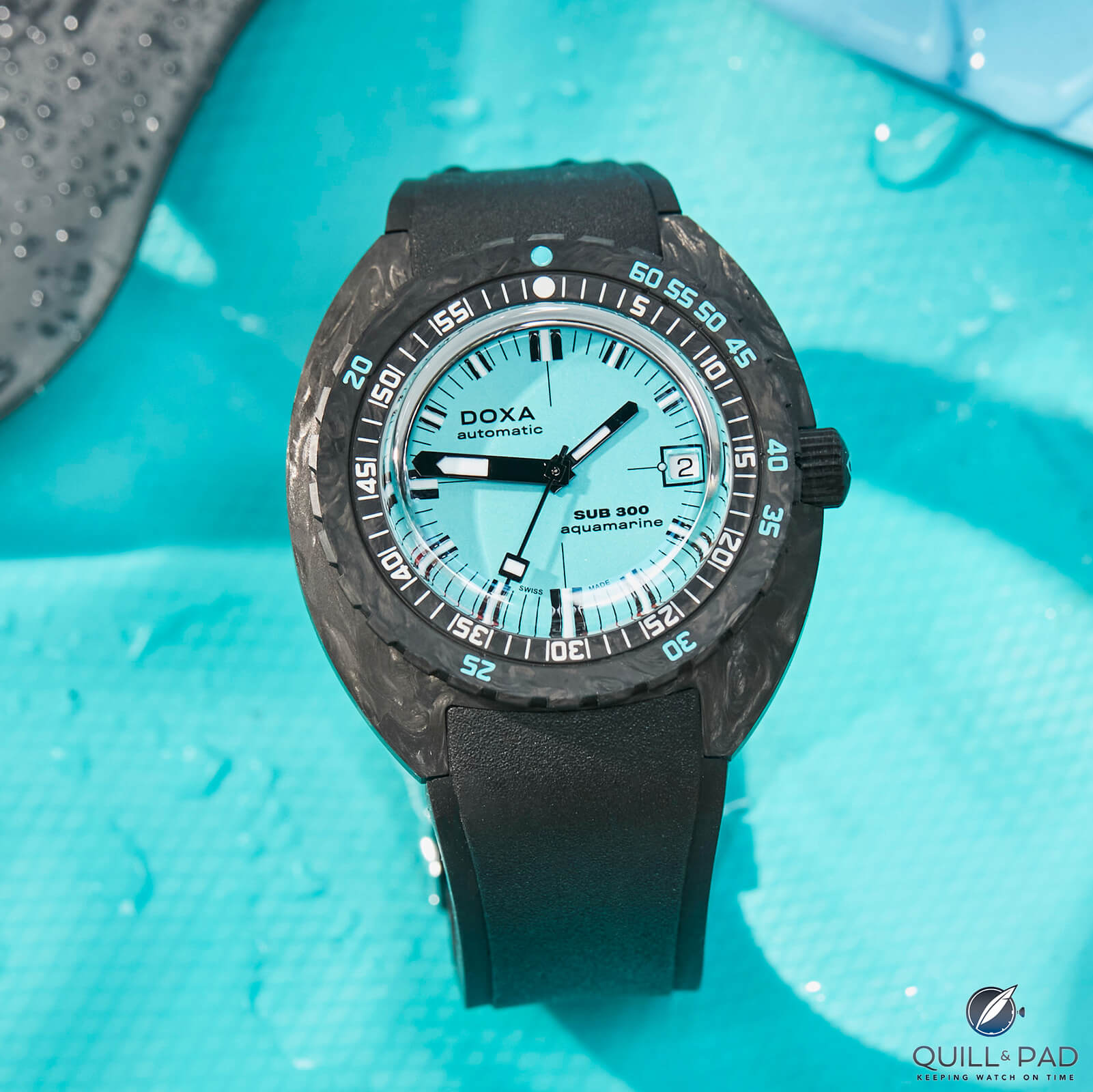
Doxa SUB 300 Carbon COSC Aquamarine
MG: Doxa can be seen as the godfather of diving watches, and one might even almost forget that the brand’s rich history even included timepieces like the Grafic, a Bauhaus-styled dress watch.
What I like most about the chronometer-certified SUB 300 is that it is a tool, yet it still offers a vibrant contrast between the black carbon case and the aquamarine-colored dial, strap, and other details. This is form and function at its best. It is a capable diving watch, yet at the same time a statement of style. This also makes it my winner in this category.
JM: The Doxa Sub 300 Carbon is an old classic in a new suit and should have a very solid fan club. While it never gained the luxury gravitas of watches like the Blancpain Fifty Fathoms, Rolex Submariner, or Panerai Submersible, the Doxa Sub 300 was a mainstay in the diving watch sector for years and still maintains a healthy respect.
This model features everything you need in a competent diving watch, and the new carbon case is supplemented by a titanium inner casing to protect the movement to the 300-meter depth rating. But I fear it may be a bit divisive with the carbon case as it may not seem as durable as a steel watch, and this might cost it the top spot even though it is an awesome value. It’s my runner-up and I would be happy to see it recognized.
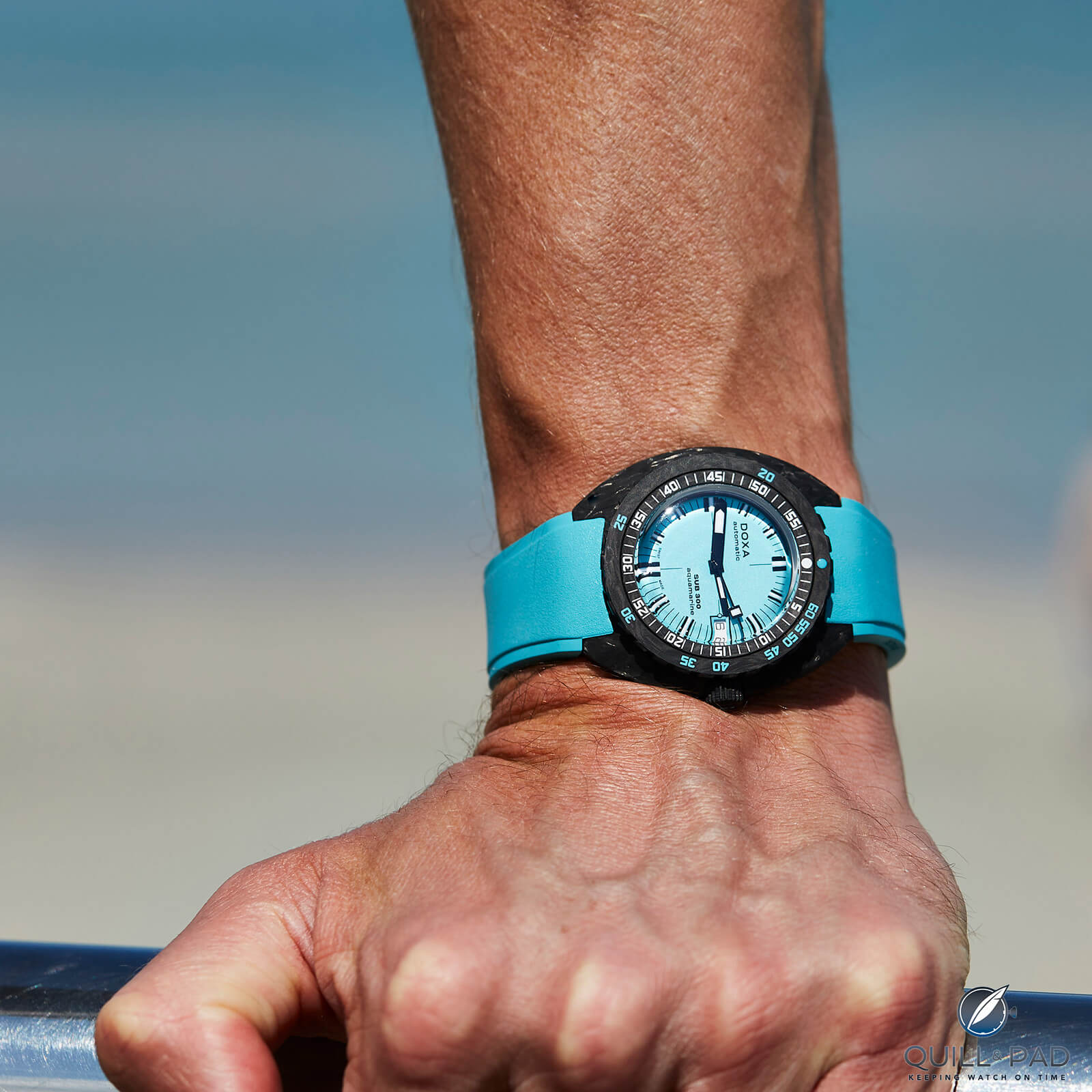
Doxa SUB 300 Carbon COSC Aquamarine
ED: Wow, that’s a fantastic color combination! It’s pretty and functional. Though I will nitpick by saying that that color is not really “aquamarine” – it’s too vibrant for that. It more a teal or almost turquoise. But I can let that slide.
I’ve also decided to go with Martin’s method on this category by separating the desk divers from the real divers, so it’s relevant to note that Doxa has made real diving instruments since 1967; it’s actually this brand’s claim to fame.
This watch comes in a total of six vibrant colors, one just as appealing as the next. The beautiful blue coloring of the dial and strap of this variation have convinced me that it works for both real and desk divers: it’s my winner here too, Martin.
IS: The bright aquamarine blue dial and strap visually (and attractively) dominate this otherwise very practical underwater tool watch. We did see a model from this line in this category last year, but that’s more than balanced out by the Aquamarine’s many attributes. The indications are all highly legible, it’s large but not overly so, 300-meter water resistance is impressive for the price, and Doxa knows how to make real dive watches.
It’s everything I want in a high-quality dive watch. I love it and think the jury will love it too. The Doxa SUB 300 Carbon COSC Aquamarine is my pick to win this category.
Quick Facts Doxa SUB 300 Carbon COSC Aquamarine
Case: 42.5 x 45 x 10.72 mm, forged carbon, titanium inner chamber for pressure resistance; screw-down crown; 300 m water resistance
Movement: automatic Caliber ETA 2824, power reserve 38 hours, 4 Hz/28,800 vph frequency; official C.O.S.C. chronometer certification
Functions: hours, minutes, seconds; date
Price: $3,890 / 3,790 Swiss francs
Louis Vuitton Tambour Street Diver Skyline Blue
JM: I am enamored with this watch and its style, and it honestly feels like it would function rather well for a dive watch thanks to its internal rotating bezel, large lume-filled hands, clear indications, and lack of superfluous details to distract from the purpose of the watch. But – and this is a frustrated but – it only has water resistance to 100 meters (not the 300 it should have to be a dive watch), which is why it is called the “Street Diver.”
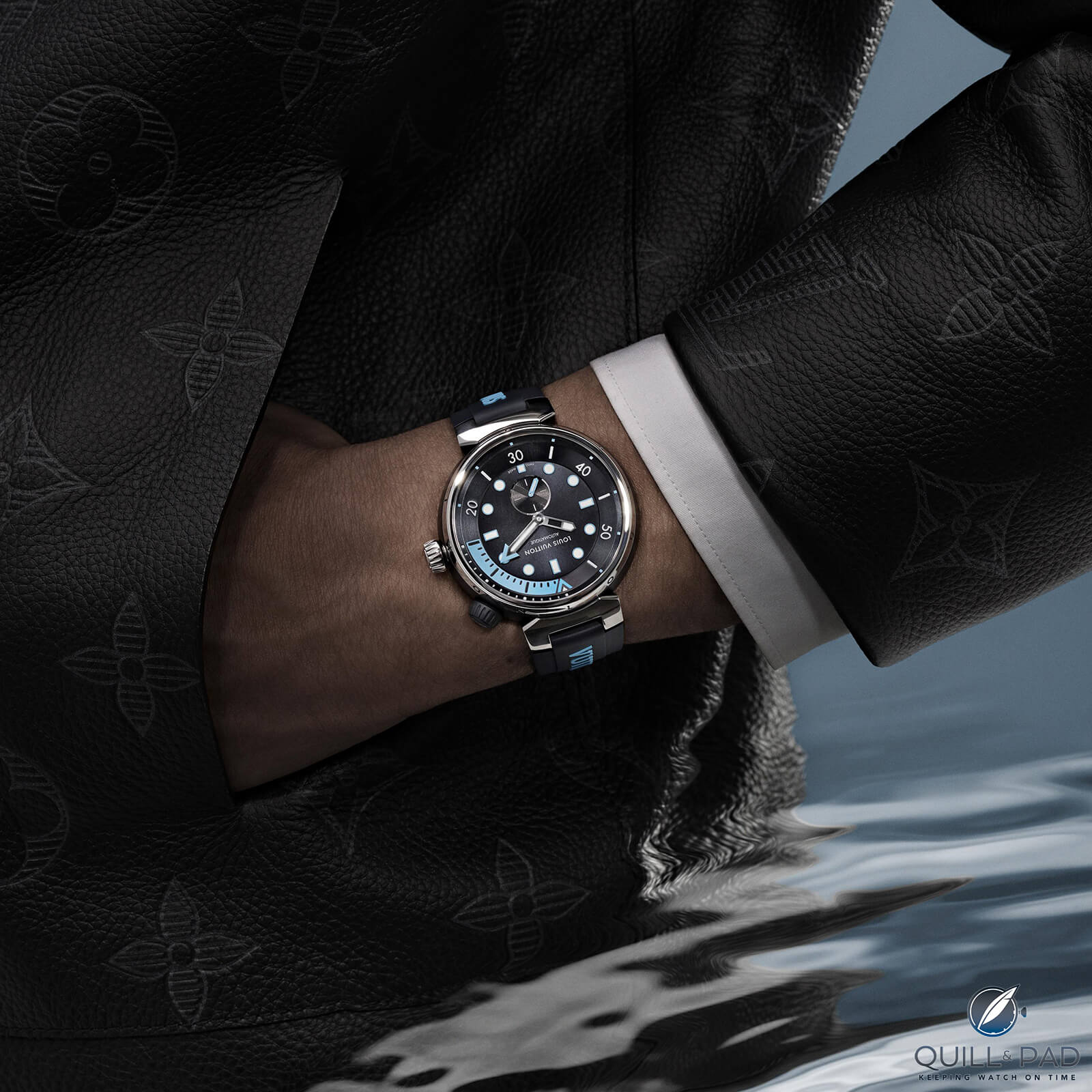
Louis Vuitton Tambour Street Diver Skyline Blue on the wrist
Also coming from Louis Vuitton, I am positive it will be dismissed by quite a few as simply a fashion watch. If it had 300 meters of water resistance, I would say that this is a solid competitor and could very well take the category. My actual choice for a winner is very similar to this watch but has the necessary depth rating to edge this piece out. Still, props to Louis Vuitton for making a solid water-resistant, diver-styled watch. If the brand increased that depth rating then I think people would have to take it seriously.
MG: Louis Vuitton is very upfront regarding its diving watch named Tambour Street Diver: this fashionable brand knows that diver’s watches are in style these days and no longer purely a tool. While this watch is definitely not afraid of water, it would probably not be the first choice as a real diver.
My biggest objection is the small seconds as here it takes longer to check and see if your watch is still running than on a diver’s watch with a centrally mounted second hand. That aside, as a “desk diver” this watch is superb and even rather original in how several general diver’s watch design cues are incorporated.
ED: I’m not a real fan of this watch. I get the trend and I get that Louis Vuitton is following that (and probably rather successfully), but I just can’t seem to love this stylized style, though I realize I’m probably in the minority.
Of course, I would also hope that this watch would never be used as a real diver’s watch, either. That could be dangerous. However, the “Street” in the name already gives away that that wouldn’t be a good idea.
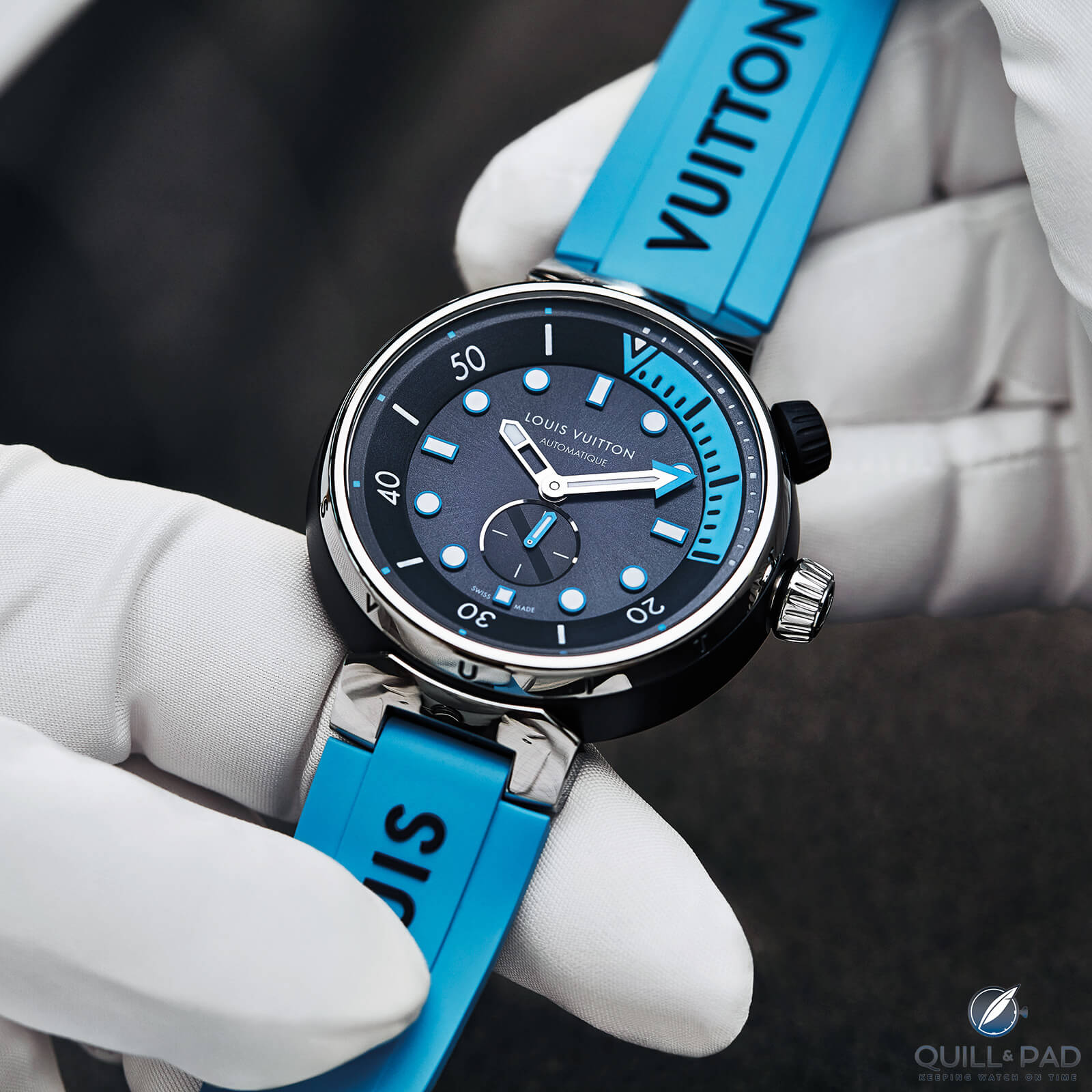
Louis Vuitton Tambour Street Diver Skyline Blue
GG: The Louis Vuitton Tambour Street Diver Skyline Blue has an odd, pinched look about it that gives away the fact that the movement, visible through the display back, is considerably too small in diameter for the size of the watch. It’s also the laggard among this group in water resistance. Overall, I think naming it a “street diver” is just about right.
IS: The Louis Vuitto Tambour Street Diver Skyline Blue is a great-looking watch from above, but that small movement says to me that it is more about the looks (and price) than the mechanics. However, I tip my hat to Louis Vuitton for designing such a great new contemporary dive watch look.
Most dive watch designs are all variations on a (Submariner) theme, and I love this fresh take: it looks modern but sacrifices nothing in practicality. The indications are all highly legible and the rotating inner bezel is secure. I would have preferred a larger movement but suspect buyers will appreciate the lower price the smaller movement allows. I don’t think it will win because of possibly decisive (you like or you don’t) contemporary design, but I rate it highly.
Further reading:
Louis Vuitton Tambour Street Diver: All Killer, No Filler?
Quick Facts Louis Vuitton Tambour Street Diver Skyline Blue
Case: 44 x 12.8 mm, stainless steel with navy blue PVD coating, 100 m water resistance
Movement: automatic Caliber ETA 2895-2, 50 hours power reserve, 28,800 vph/4 Hz frequency
Functions: hours, minutes, seconds; dive-time bezel under the crystal
Price: $7,505 / 6,350 Swiss francs
Milus Archimèdes Orange Coral
ED: When did Milus get resuscitated and rebranded as a maker of sports watches? This is certainly new – at least in comparison to the elegant and rather expensive watches of the Milus I last knew in the mid-2000s.

Milus Archimèdes Orange Coral on mesh bracelet
As it turns out, Milus had a “Super Compressor” diver’s watch in the 1970s (that looks a lot like the historical Jaeger-LeCoultre Polaris to me). The “compressor” was a case back that compressed on gaskets underwater to create a tighter seal. Though this new watch looks nothing like that one, it certainly has a number of “right” elements to make it a more serious diver’s watch, including its signal orange dial, 300-meter water resistance, and a discreet helium escape valve recessed in the case band at 9 o’clock.
As Milus is also donating a portion of the proceeds of the watch to an environmental foundation for its Orange Coral Project, I have to say (without ever having handled it) that this watch is an incredible bargain and I love that aspect.
GG: The Archimèdes by Milus Orange Coral and Oris Aquis Date Calibre 400 41.5 mm both look to be solid, attractive, and affordable watches, and are certainly on trend with their brightly colored dials; that said, they are each so conventional in other ways that it’s tough to pick either at the top of the group.
JM: This is my winner when it comes to features, style, and simplicity. It has the internal bezel like the Louis Vuitton but comes with screw-down crowns and the full 300-meter depth rating, taking the best of another favorite and making it better. It has a vintage appeal for those who like the more traditional diver styling, and it doesn’t add any extra details to clutter up the dial while still being functional in and out of the water. What’s more, this is the most affordable watch in the category by $1,000 and is 10 times less expensive than the highest-priced piece.
To put the icing on the cake, proceeds from the sale of the Archimèdes go to adopt and save a section of a coral reef, creating a positive impact on the environment, something clearly close to the heart of Milus. This piece may not have the longest power reserve, an advanced escapement, or unique complications, but it does a fantastic job as a diving watch at a great price, and to me that is a high value deserving of a win.
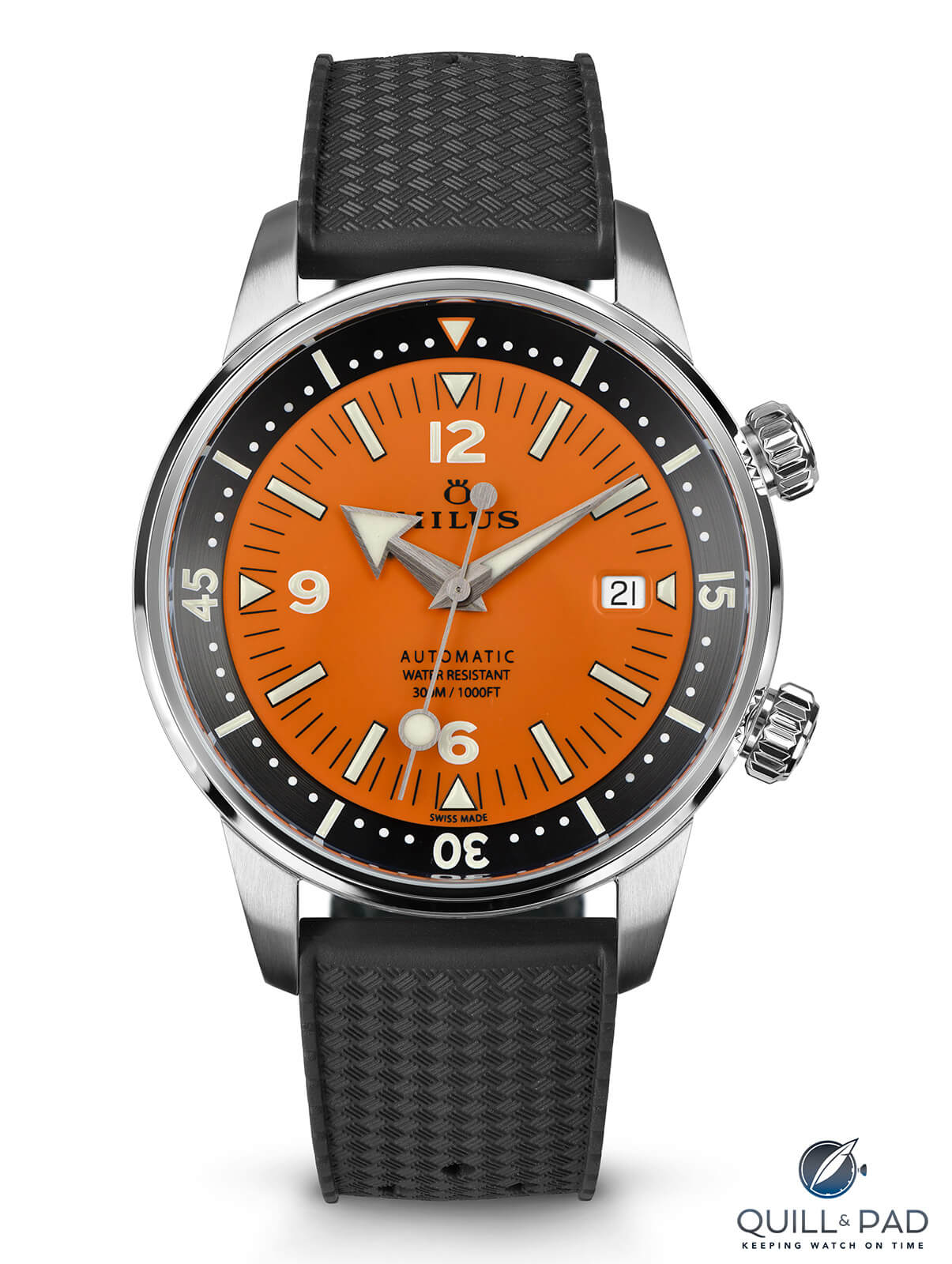
Milus Archimèdes Orange Coral on rubber strap
IS: I just can’t pin this Milus Archimèdes Orange Coral down: I like it (I think) as a watch, and the Milanese bracelet adds a nice visual touch (for a dive watch, though?), but I can’t decide if it’s just an old 1970s design or a modern retro look. And why enter a watch on a mesh bracelet in a dive watch competition when you also offer it on a rubber strap? The inboard white date wheel (a pity it does not match the dial) highlights how small the movement is in the case, but I’ve no doubt it is up to the job and it keeps the price down. I can’t see it as a winner, but wouldn’t be surprised if it has lots of fans.
MG: Between all the competing watches, the Milus is perhaps the most old school. In my opinion, a bit too much even. While this is one watch that I never handled, the dial is off to me. While I think that the design is classic, the Arabic numerals 6, 9, and 12 make it look cluttered. And unlike the hour markers, they are not outlined in black, making them look a bit cheap.
Given this watch’s sturdy ETA movement, 300-meter water-resistance, and sensible size of 41 mm, it does offer everything you can ask for in a diver, though.
Quick Facts Milus Archimèdes Orange Coral
Case: 41 x 11.9 mm, stainless steel; 300 m water resistance, extra crown for setting the underglass diver’s bezel
Movement: automatic ETA Caliber 2892-A2, power reserve 42 hours, 28,800 vph/4 Hz frequency
Functions: hours, minutes, seconds; date
Limitation: 50 pieces
Price: 2,119 Swiss francs
Remark: watch delivered with both rubber and steel mesh straps
Oris Aquis Date Calibre 400 41.5 mm
ED: Oris has always been one of my favorite brands for sensible prices and great quality. And I am finding that 2021 has just been this brand’s year – Oris seems to be able to do no wrong. The movement in this watch is incredible with its five-day power reserve, and 300-meter water resistance is nothing to sneeze at. The dark color scheme of this watch might prevent it from being terribly useful as a real diver, but it certainly comes close to the idea. This watch also comes in two other colorways, one of which is a blue so beautiful it makes me wonder why the brand entered this green-dial variation.
With a ten-year guarantee (!!), this is my runner-up in this category.
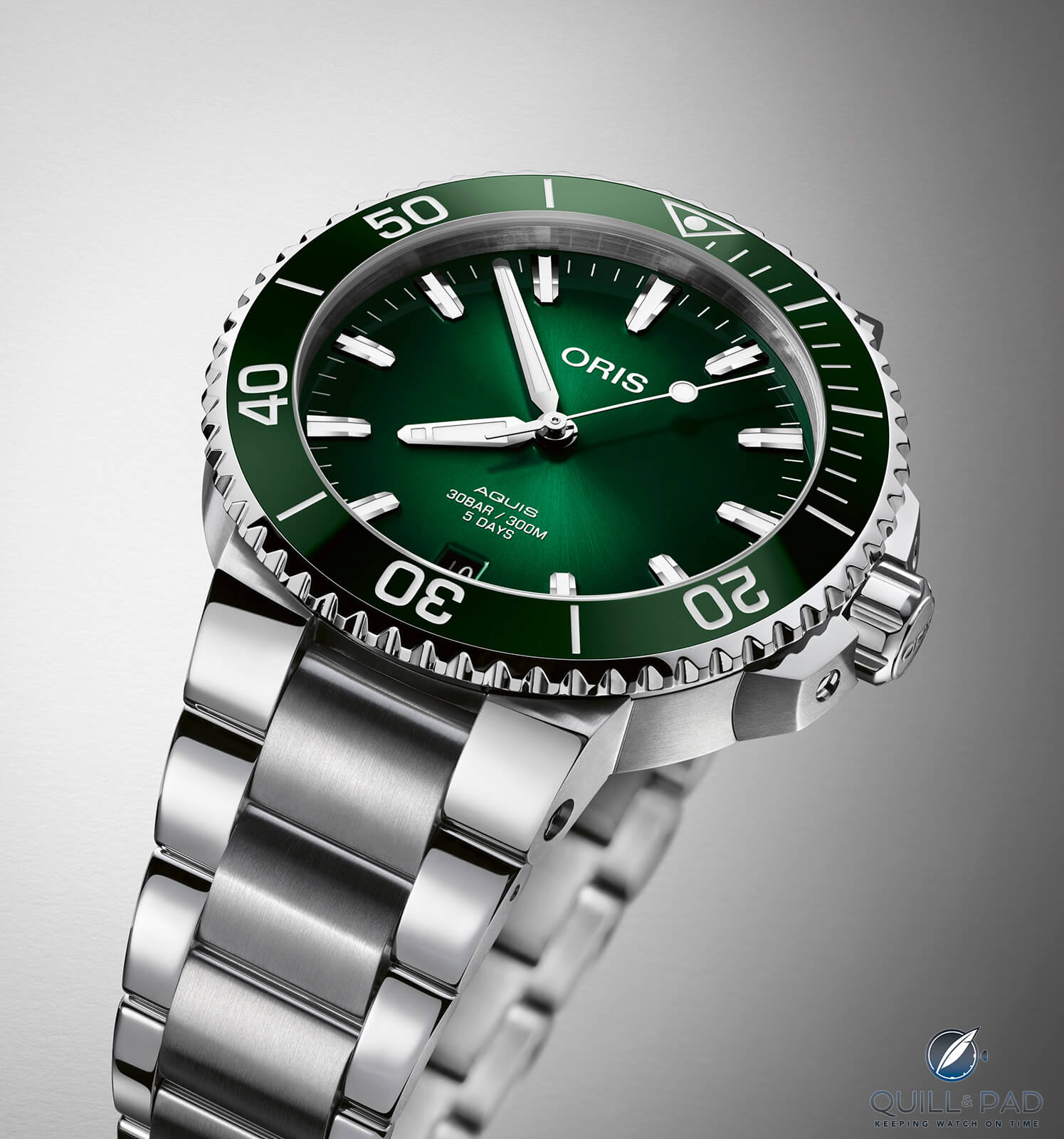
Oris Aquis Date Calibre 400 41.5 mm
MG: Oris is another brand capable of making great diving watches, and the Aquis has always been a personal favorite of mine. This one follows the trend of green watches, and although I still find it an odd hue to see on a diving watch, it looks good.
What I like about Oris is that the brand is also on point with ensuring that its movement also evolves. Its Caliber 400 offers a five-day power reserve, ten-year warranty, and recommended ten-year service intervals. That makes for an impressive diving watch at a still relatively modest price.
IS: I’m with you, Martin: the Oris Aquis Date Calibre 400 41.5 mm offers a lot of value for the money, especially with that magnetic-resistant escapement in the impressive ten-year warranty movement. That all makes for a great diver’s tool for me too. But the green dial just doesn’t work for me, and it doesn’t look like a 2021 model watch; the design needs a refresh.
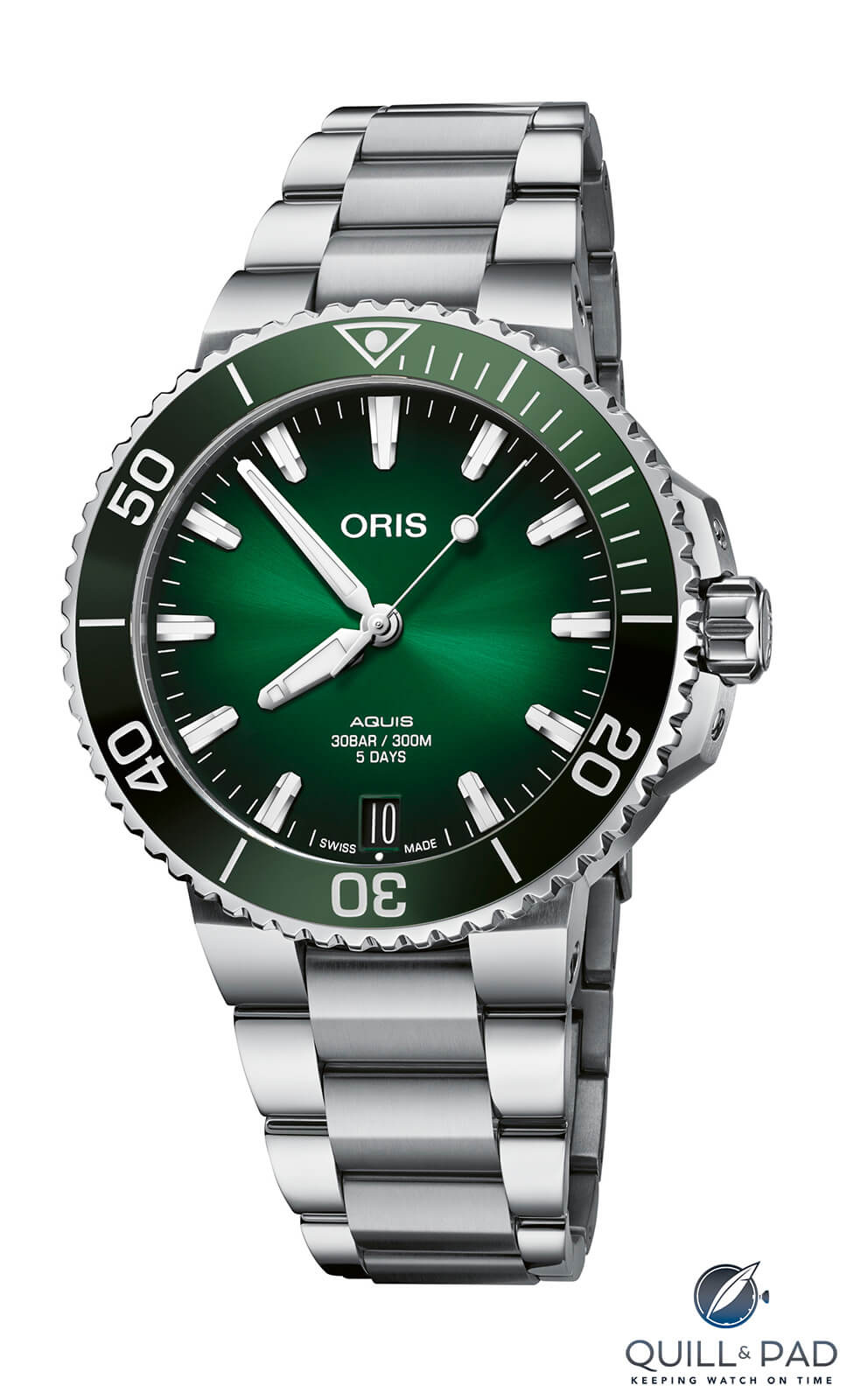
Oris Aquis Date Calibre 400 41.5 mm
JM: The Oris Aquis Date is an incredibly solid watch with some great features such as a five-day power reserve, silicon escapement, and a 10-year warranty. It also is the second most affordable watch after the Milus, something that should never be discounted for a tool watch. But I feel the design is lacking in creativity or clear brand recognition; it seems a bit too diluted and akin to other big names and micro brands alike, leaving little lasting impression on me after I see it. It is a great value, and I really like Oris and what it has been doing for conservation as well, but I don’t know if this watch stands out enough to win. I’m sure most people will like it, but will they love it enough to pick it for the trophy?
Quick Facts Oris Aquis Date Calibre 400 41.5 mm
Case: 41.5 x 13.1 mm, stainless steel, 300 m water resistance
Movement: automatic Caliber 400, 120-hour power reserve, 28,800 vph/4 Hz frequency, silicon escapement
Functions: hours, minutes, seconds; date, power reserve
Price: $3,500 / 3,250 Swiss francs
Remark: ten-year guarantee
Reservoir Hydrosphere Bronze The Greg Lecoeur Edition
GG: I love the look of the Reservoir Hydrosphere Bronze Greg Lecoeur Edition. In fact, I prefer its overall appearance and deep blue gradient dial even to the more dramatic Ulysse Nardin. I’m still put off, however, by the fussy two-scale bezel for dive timing necessitated by the retrograde minutes indication that makes this piece pretty much useless as an actual dive watch. The choice of bronze as a case material also seems a bit odd for a watch designed to be immersed in salt water, but as a landlubber piece it is appealing indeed.
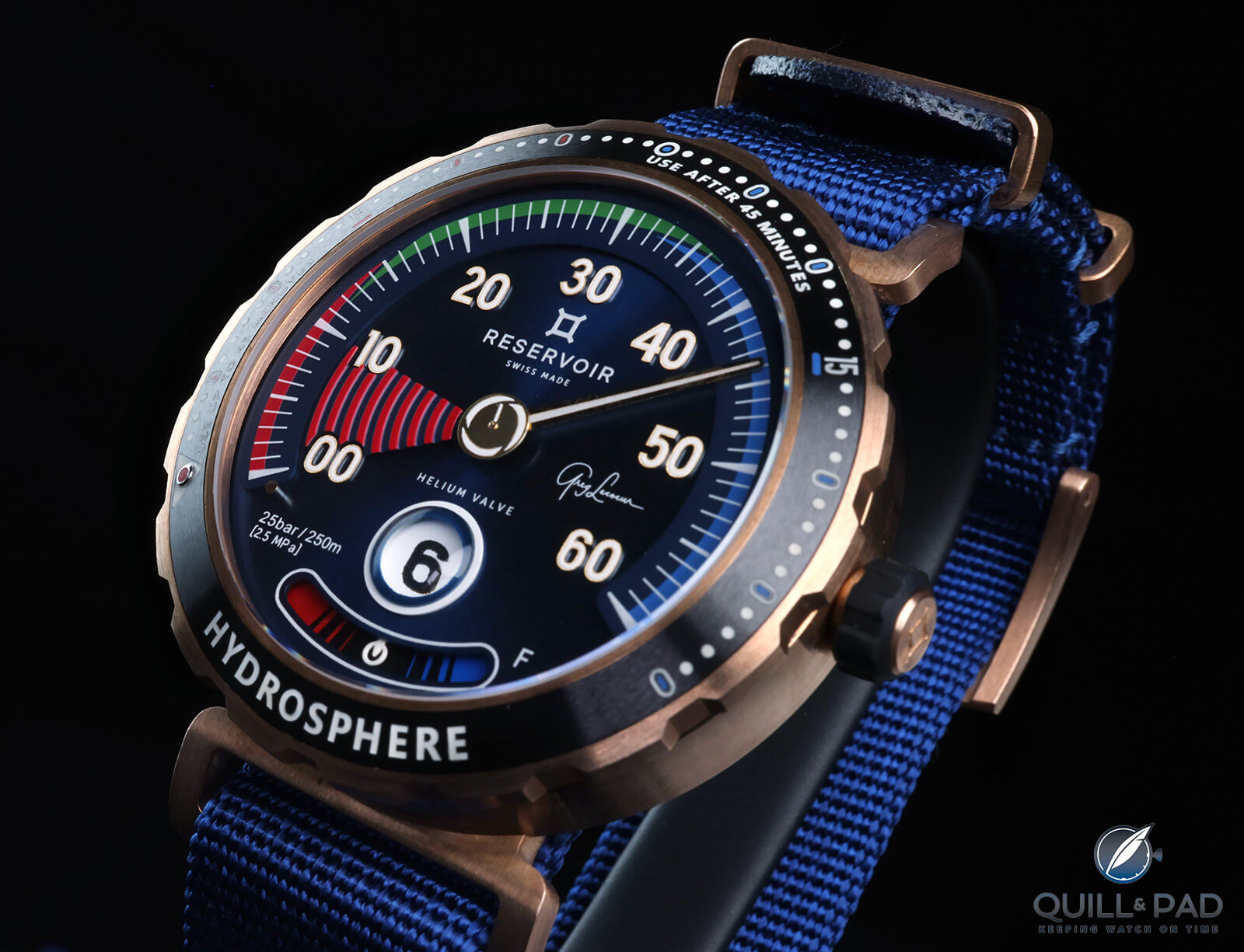
Reservoir Hydrosphere Bronze The Greg Lecoeur Edition
MG: While I love the work of Reservoir, this makes no sense to me as a diving watch. In a dangerous environment, where mistakes can be lethal, the last thing you want is a watch that can be somewhat confusing. However, it looks remarkably good on land.
ED: This watch has never made much sense to me as a real diver’s timepiece. It is attractive, and I also like the combination of unusual displays, but I would hope this piece is never actually relied upon as an underwater instrument: its signature retrograde minutes and jump hour complication render the reading of elapsed underwater time just about impossible for me (and probably anyone else) to read in a hurry. It would seem like a nightmare scenario underwater, especially if you are panicking in any way.
Also to note: Reservoir also entered a bronze variation in the 2020 GPHG Diver’s category, and this one is CHF 500 more even though it is essentially the same watch with a different name and color scheme.
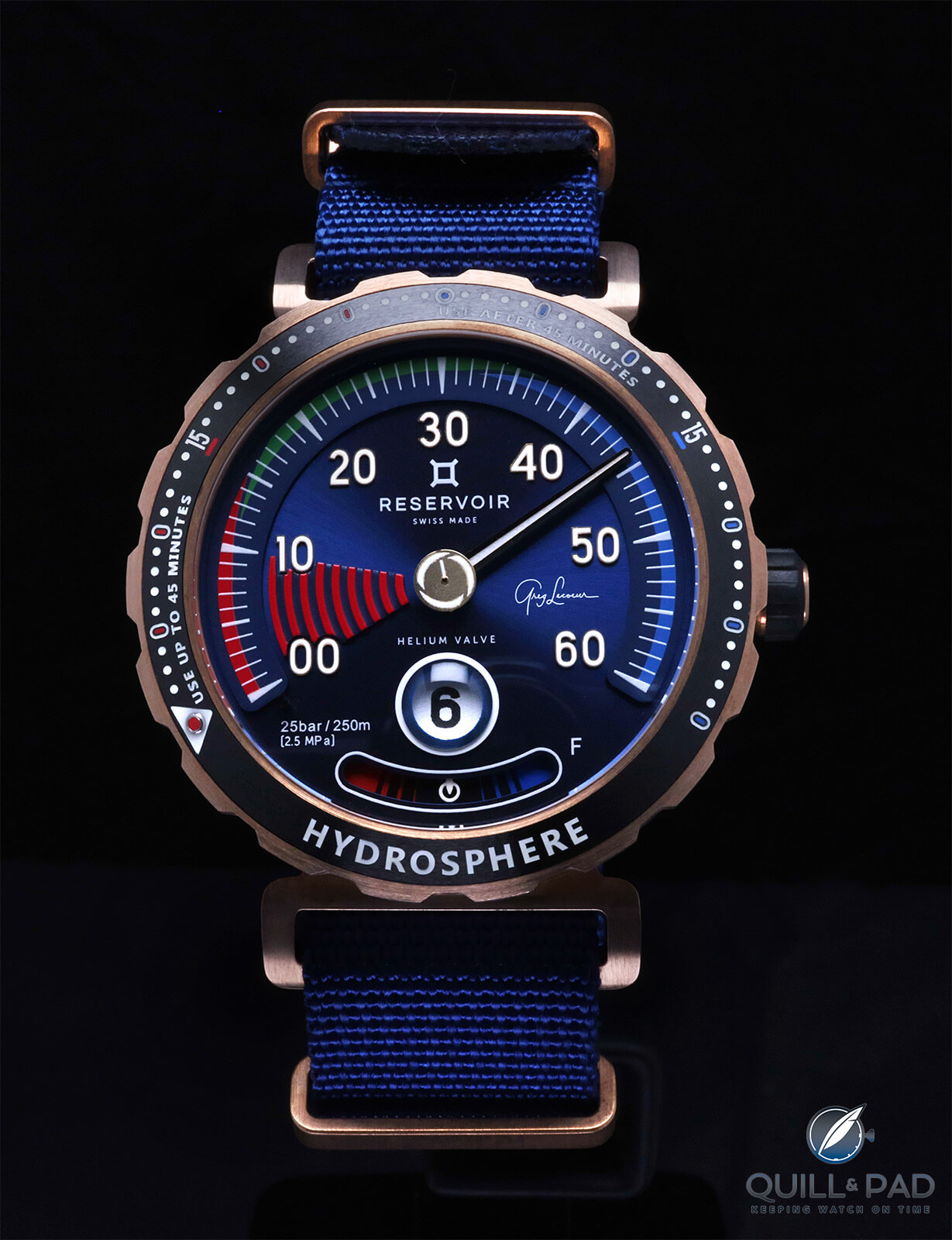
Reservoir Hydrosphere Bronze The Greg Lecoeur Edition
IS: I don’t get it. I like Reservoir’s distinctive look, but don’t understand how it qualifies (for the second year in a row) in the Diver’s category. Yes, the Hydrosphere Bronze The Greg Lecoeur Edition is rated to a respectable 250 meters, so I suppose that’s enough to qualify. However, on a diver’s watch you want maximum legibility, and the maximum is using the full 360 degrees of the dial space for the largest possible indications, numerals, and markers. The retrograde minutes – minutes being the most important indication on the dial of a diver’s watch – here only use only two-thirds of the dial space. That’s too much of a “design versus instrument” compromise for me in a dive watch.
JM: I really like Reservoir and its instrument styling, especially since it employs jump hours and retrograde minutes, some of my favorite horological mechanisms. But like my original requirements for this category state, a diving watch must first and foremost be functional. I do not think the fun mechanics are a good fit for a diving watch as reading the elapsed dive time isn’t intuitive thanks to the smaller scale of 60 minutes and that the bezel has two different sections to use depending on what time the dial reads. This is too confusing for reading at a glance and could easily be messed up. So even if I like the style, I just don’t think it has what it takes to be a great dive watch.
Further reading: Reservoir Watch Supercharged Classic: (Relatively) Affordable Swiss Quality
Quick Facts Reservoir Hydrosphere Bronze The Greg Lecoeur Edition
Case: 45 x 14.9 mm, bronze with ceramic bezel and helium valve, 250 m water resistance
Movement: automatic Caliber ETA 2824-2, 37-hour power reserve, 28,800 vph/4 Hz frequency
Functions: jumping hours, retrograde minutes; power reserve indication
Limitation: 50 pieces
Price: 4,850 Swiss francs
Ulysse Nardin Diver X Cape Horn
GG: The Ulysse Nardin Diver X Skeleton either is, or isn’t, a proper dive watch, but it’s my pick in this year’s category. I’m a fan of UN’s “X” design theme overall, and I think the brand has done a solid job applying the design cues to a credible dive watch. I particularly like the concave, unidirectional bezel that flows into the domed front crystal, and the copious use of Super-LumiNova meets the legibility test.

Ulysse Nardin Diver X Cape Horn
At least from the photos, the titanium case and blue Carbonium bezel are well matched and provide a touch of visual contrast without losing coherence. The 200 m water resistance is in the middle of the group of nominees, but that doesn’t deter me from awarding it my top spot.
ED: Ulysse Nardin appears to have entered much the same watch it did in 2020. However, there are more differences than just the skeletonized dial, what looks like a different color scheme, and strangely 100 meters’ less water resistance.
The new Diver X Cape Horn is powered by the new openworked UN-372 caliber with 96 hours’ worth of power reserve.
The titanium case features a blue Carbonium bezel, a material that is a lightweight and durable composite material used in aerospace. Aside from a great strength-to-lightness ratio, it leaves a marbled effect on the surface that is unique in each watch.
Nonetheless, it is too difficult to read to be used for real diving.
MG: Like you, I have the same issue with this Ulysse Nardin that I do with the Reservoir: it is a great-looking watch but skeletonizing it doesn’t help its legibility. That simply makes it great for land, swimming, and snorkeling. It still comes up short of winning this category in my book.
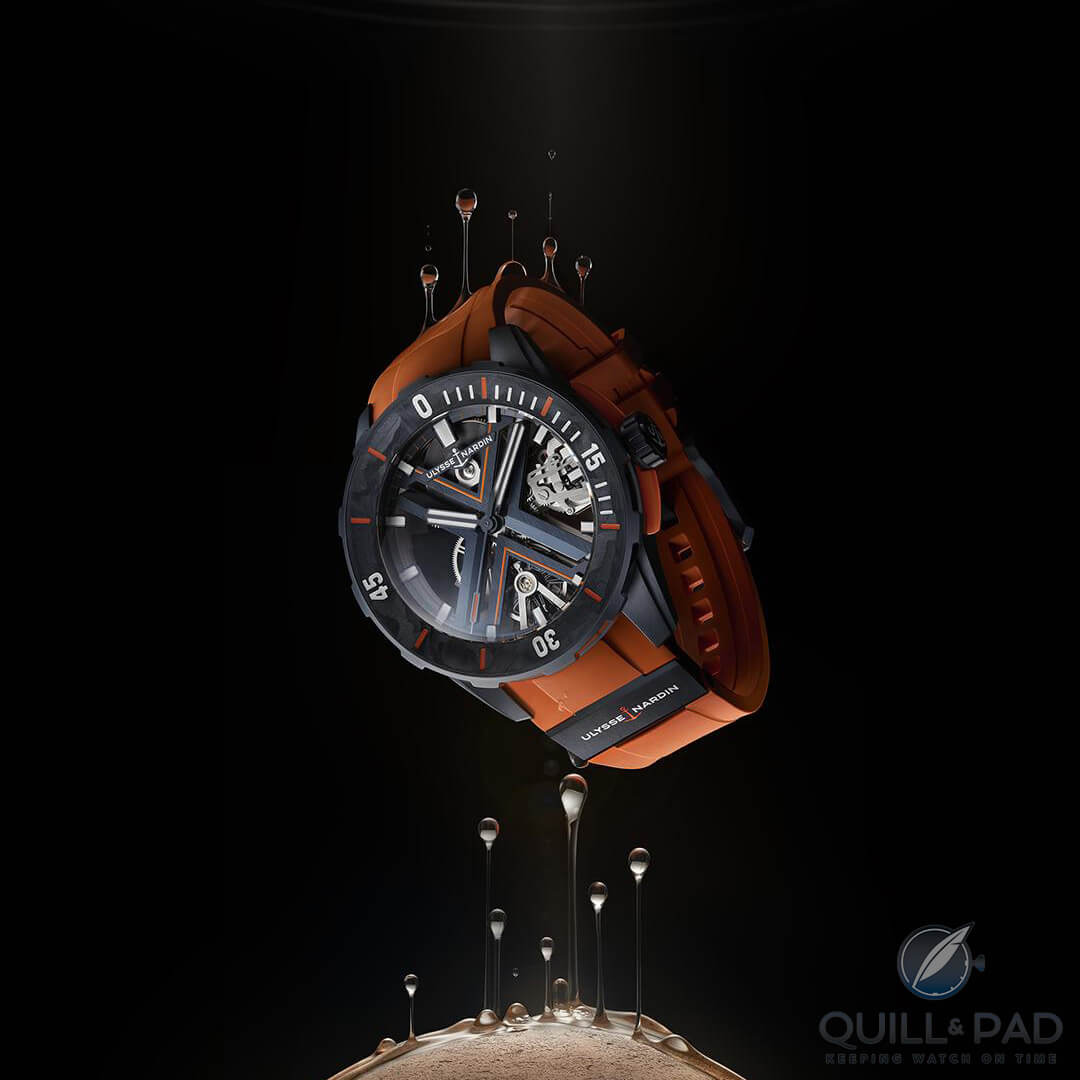
Ulysse Nardin Diver X Cape Horn
IS: My guess is that the bold, aggressive style of the Ulysse Nardin Diver X Skeleton will be polarizing (again, you love it or you don’t) and split the jury. What rules the Diver X Skeleton out for me here is that the watch’s main feature – that big skeletonized X – makes it too hard to take seriously as a diver’s watch. Maximum legibility is high up in my criteria for this category.
JM: This is a bad dive watch that is still really cool and has a lot of nice details. The dial is too confusing to see at a glance, though I could forgive that if it disappears at depth and only the lume is visible. But still, the emphasis of this watch isn’t diving; it is aesthetics and showcasing its very cool movement and silicon escapement. It’s also the most expensive watch in the category, coming in over 20,000 Swiss francs, and I just don’t see it being held up comparably to the other more purpose-built diving watches.
It’s a cool watch from a brand I really enjoy, but it seems like the brand entered this piece more for marketing than competition, because we all know that Ulysse Nardin can make a great and simple diving watch.
Further reading: Ulysse Nardin Blast: Highly Volatile Explosive
Quick Facts Ulysse Nardin Diver X Cape Horn
Case: 44 x 15 mm, titanium with blue Carbonium bezel, 200 m water resistance
Movement: automatic Caliber UN-372 with silicon escapement, 96-hour power reserve, 21,600 vph/3 Hz frequency
Functions: hours, minutes, seconds
Limitation: 175 pieces
Price: 21,000 Swiss francs
Predicted winners
Martin: Doxa SUB 300 Carbon COSC Aquamarine
Elizabeth: Doxa SUB 300 Carbon COSC Aquamarine
Ian: Doxa SUB 300 Carbon COSC Aquamarine
Joshua: Milus Archimèdes
Gary: Ulysse Nardin Diver X Cape Horn
You may also enjoy:
Leave a Reply
Want to join the discussion?Feel free to contribute!





















































Once again the question comes to mind: Are there as many divers as there are dive watches?
I really like your blog very informative and helpful me thanks for the info.